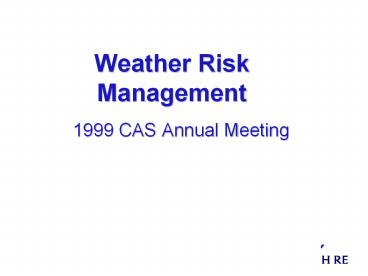Weather Risk Management
Title: Weather Risk Management
1
Weather Risk Management
- 1999 CAS Annual Meeting
2
What is Weather Risk?
- Uncertainty in earnings or cash flow caused by
weather volatility. - It can be the largest source of financial
uncertainty for many companies - particularly
energy companies. - There are no physical markets or underlying
commodities. - Cannot be controlled (Mother Nature.)
3
Weather Hedge Some Examples
- Utilities and energy companies can protect volume
related-revenue - Agricultural companies can protect earnings from
freeze and drought - Golf Course Management Companies can protect
against a heavy rain season - Sports Drink Manufacturers can protect against
depressed earnings from a cool summer season - Municipalities can protect snow removal budgets,
utility costs, and maintain a more stable revenue
flow from parks and beaches
4
Weather Risk Management Structures
- Climactic protection can be designed for
- Temperature (HDD/CDD)
- Precipitation or snowfall
- Humidity
- Wind speed
5
Heating and Cooling Degree Days
- Most temperature contracts in current practice
are based on Heating Degree Days (HDD) for winter
protection, and Cooling Degree Days (CDD) for
summer protection. - HDD Max (0, 65 F - average temperature in a
day) - CDD Max (0, average temperature in day - 65 F)
6
How Weather Options Work
- Pay off is based on a measurable index (CDD, HDD,
etc) - Pay off is based on how the index performs
relative to a trigger or strike value - not on
actual loss - Coverage usually has a defined maximum limit
7
Designing Coverage for the Client
- Identify the weather exposure, and the weather
statistic associated with that risk. - Determine the geographic areas where you have
margins at risk. Identify related weather
stations. - Select a strike - normally 1/2 to 1 full standard
deviation from the mean. Strikes closer to the
mean are obviously more expensive, and clients
should try to avoid dollar swapping.
8
Basic Types of Option Contracts
- Put Option - pays off if the index at the end of
term is below the predetermined strike - Call Option - pays off if the index at the end of
term is above the predetermined strike - Swap - pays off on both sides (above and below) a
predetermined strike - Collar, Strangle, Etc.
9
Coverage as Insurance or Derivatives
- Climate coverage can be structured as
- Derivatives - An international swap dealers
association (ISDA) confirmation is issued to the
client - Insurance - an insurance policy is issued, but
still indemnifies for loss based on a stated
amount per unit of the index
10
Heating Degree Days - An Example
- Problem A natural gas supplier in the New York
City area experiences large decreases in revenue
during mild winters due to low heating demand.
This significantly impacts earnings per share and
puts downward pressure on their US stock price.
Each lost heating degree day during the winter
(below normal) decreases earnings by 50,000. - Solution A Heating Degree Day (HDD) put option
which pays 50,000 per heating degree day below
the pre-determined strike.
11
New York HDD Put Example
- Put Option Features
- Period Nov-Mar
- Strike 4,000
- Floor 3,800
- Tick 50,000
- Limit 10 mil
- Price 2.5 mil
12
Snowfall Cover - An Example
- Problem The municipality of Fort Wayne, IN has
budgeted 1,000,000 for snow removal for the
upcoming winter period. The budget allows for the
removal of 12 inches of snow. The municipality
estimates that for every 1/2 inch of snow in
excess of 12, they incur 20,000 in additional
product and labor costs. - Solution A Snowfall call option which pays
20,000 per 1/2 inch of snowfall above the
pre-determined strike (i.e. 12 inches).
13
Pricing of Exposure
- Historical Data
- Data Adjustments
- Stochastic Modeling
14
New York HDD Data
15
Weather Data
- Historical data from NCDC
- 50 years or more available for most major cities.
16
Data Adjustments
- Station Changes
- Trends
- Global Climate Cycles
- Urban Heat Island Effect
- Population Densities
- ENSO Cycles
- Forecasting
17
Stochastic Modeling
- Fit Distribution to Weather Data
- Monte Carlo Simulation
18
Issues
- State regulatory and legal issues that may arise
with a new product - Aggregate exposure management
- Overcoming an undeveloped and uneducated primary
market - Sophisticated market players
- Basis risk associated with selected weather
station - Basis risk associated with selected option
structure
19
Insurer/Reinsurer Participation
- Source of Premium/Revenue Growth
- Diversification of Risk Portfolio
- Risk Management Solutions for Clients
- Natural outgrowth - insurers already provide risk
management solutions for natural events such as
Hurricanes and Earthquakes.































